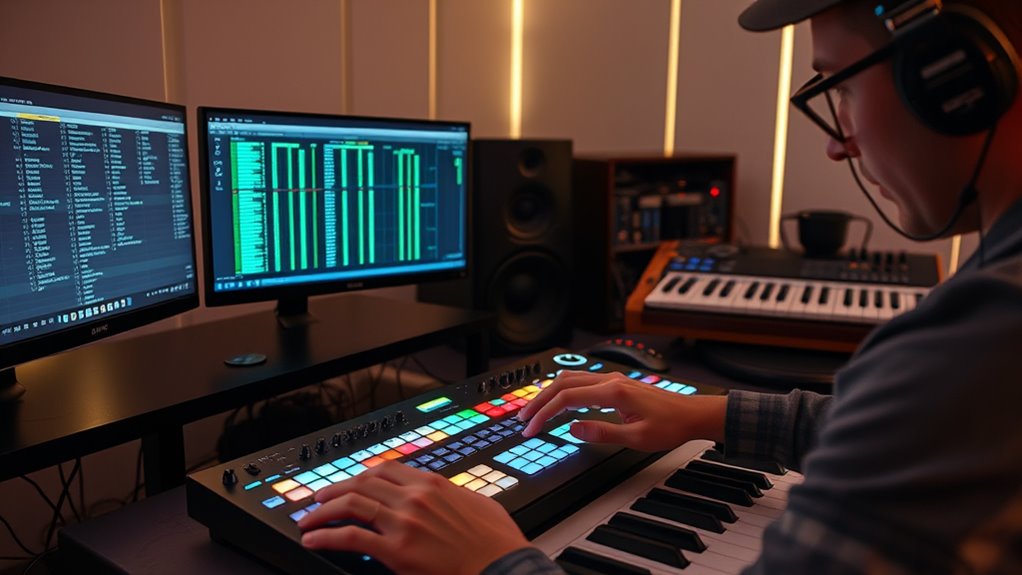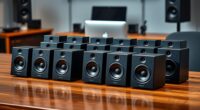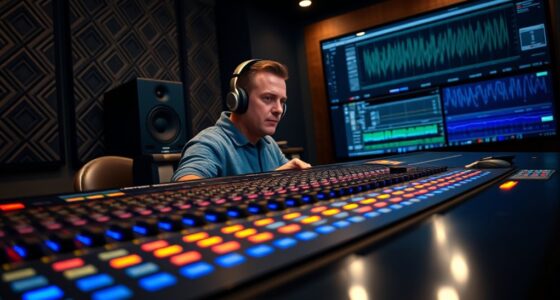To practice MIDI programming like a pro, focus on accuracy and articulation before speed. Set up a clutter-free, quiet workspace and develop a step-by-step approach by breaking down complex parts. Practice slowly, paying close attention to timing and velocity, and use tools like quantization and humanization to add natural feel. Continuously analyze and refine your work, gradually shifting focus from precision to efficiency—if you keep honing these skills, you’ll master professional-level MIDI programming.
Key Takeaways
- Focus on precise note timing and velocity to build a solid foundation before increasing speed.
- Practice in small, manageable sections, prioritizing accuracy and detailed correction over rushing.
- Use quantization and humanization thoughtfully to balance natural feel with technical precision.
- Maintain a distraction-free environment with organized workspace to enhance concentration on accuracy.
- Regularly critically listen and adjust MIDI performance to ensure rhythmic tightness and expressive control.
Understanding the Value of Precision in MIDI Programming

Understanding the value of precision in MIDI programming is essential because small timing or velocity errors can markedly impact the overall sound quality. Microtiming consistency ensures your notes stay rhythmically tight, making your performance sound polished and professional. Even slight deviations can disrupt the groove, so paying close attention to timing details is critical. Additionally, note velocity control shapes the expressiveness of your performance, affecting dynamics and emotional impact. By mastering precise timing and velocity, you gain better control over your MIDI data, leading to more realistic and compelling results. Consistent microtiming and accurate note velocities help your MIDI sequences feel natural and engaging, making your music stand out. Focusing on genre conventions can also help you meet the expectations of your target audience and enhance your overall musical expression. Focus on precision, and you’ll profoundly improve your programming skills and sound quality.
Setting Up Your Workspace for Focused Practice
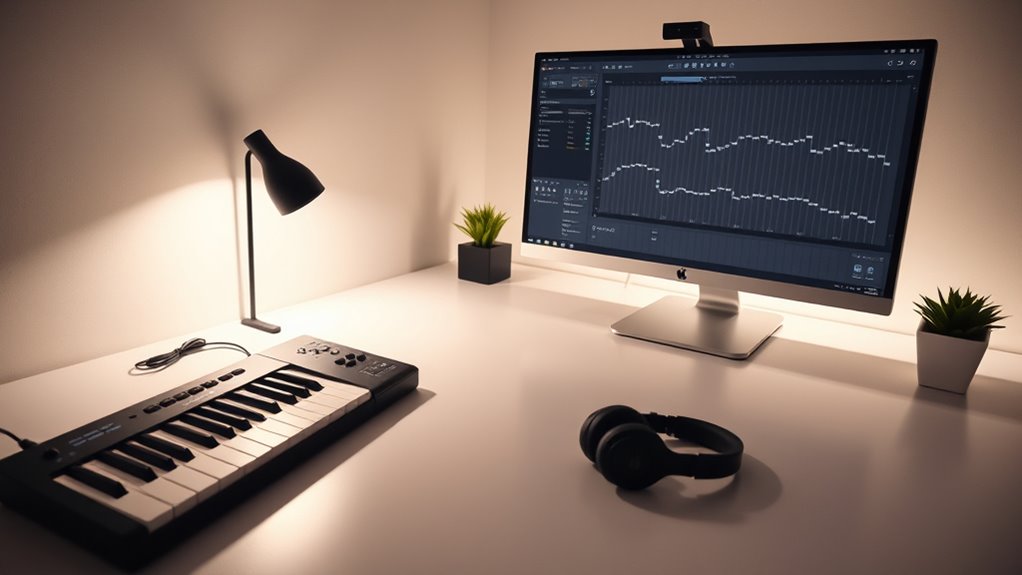
Creating a dedicated, clutter-free space helps you stay focused during MIDI practice. Keep your tools organized so everything you need is within reach, reducing interruptions. Adjust your lighting to reduce eye strain and boost concentration, making each session more effective. Incorporating performance upgrades into your workspace setup can also motivate you to practice more consistently.
Minimize Distractions Effectively
To maximize your focus during MIDI programming practice, it’s essential to set up a workspace free from distractions. Noise reduction helps you concentrate and enhances focus, making your practice more effective. Create an environment that minimizes interruptions with these elements:
- Soundproof curtains or panels to block external noise
- A quiet corner away from household activity
- A clean, clutter-free desk to reduce visual distractions
- Headphones for focus enhancement and noise isolation
- Implementing market demand considerations can help you choose the most effective equipment and setup for your needs.
Organize Your Tools Efficiently
Having a clutter-free workspace is key to maintaining your focus during MIDI programming practice. Organize your hardware so everything you need is within easy reach, reducing interruptions. Use designated storage for cables, controllers, and peripherals to keep your area tidy. This minimizes distractions and helps you stay concentrated on your task. Familiarize yourself with keyboard shortcuts for your DAW and MIDI tools; this speeds up workflow and keeps your hands on the keyboard rather than searching for functions. Keep your workspace clean and well-structured, with essential tools accessible and unnecessary items out of sight. A well-organized setup not only enhances efficiency but also fosters a focused mindset, allowing you to prioritize accuracy over speed during practice sessions. Additionally, creating designated zones for specific activities can further optimize your workflow and prevent clutter from spreading across your workspace.
Optimize Your Workspace Lighting
Good lighting is essential for maintaining focus during MIDI programming practice, as it reduces eye strain and helps you see your equipment clearly. To optimize your workspace lighting, set up ambient lighting that creates a comfortable atmosphere without glare. Use adjustable brightness options to tailor the light to your needs, preventing eye fatigue during long sessions. Consider positioning your light source to avoid shadows on your screen or keyboard. Think about:
- Soft, warm ambient lighting for a calming environment
- Brightness controls for quick adjustments
- Avoiding direct light that causes glare or reflections
- Using diffused light to evenly illuminate your workspace
Developing a Step-by-Step Approach to MIDI Sequencing
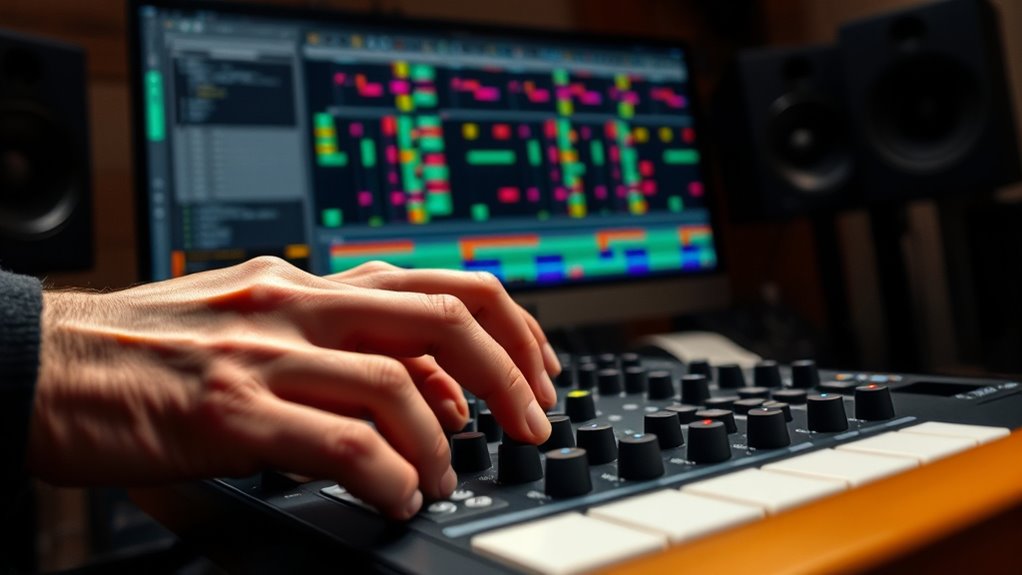
To create effective MIDI sequences, you need a clear plan for each step. Focus on planning your sequence carefully before you start, so you know exactly what you want to achieve. Practice with precision by paying attention to details, ensuring each note and timing element aligns perfectly. Incorporating signs of spoilage in your review process can help you identify and correct errors early, leading to more accurate sequencing.
Planning Your Sequence
Before diving into your MIDI sequence, it’s essential to develop a clear plan to guide your workflow. Visualize each step, from crafting musical phrasing to detailed MIDI parameter editing. To stay organized, consider:
- Sketching out the song’s structure, like verses or choruses
- Identifying key moments for expressive MIDI parameter adjustments
- Mapping out the desired musical phrasing for emotional impact
- Breaking down complex parts into manageable sections
This approach helps you focus on accuracy over speed, ensuring each note and parameter change aligns with your artistic intent. Planning also reduces errors and streamlines your editing process. With a step-by-step strategy, you’ll produce more polished MIDI sequences that sound intentional and professional.
Practicing With Precision
Developing a step-by-step approach to MIDI sequencing helps you practice with greater accuracy and confidence. Focus on precision by breaking down each task, such as editing note velocities or timing adjustments, to improve musical expression. This method guarantees you pay attention to details that enhance the emotional impact of your performance. As you refine your process, you’ll develop a clearer sense of how small adjustments influence creative improvisation. Practicing with precision also minimizes errors, making your sequences sound more professional. By consistently following a structured routine, you’ll build muscle memory and deepen your understanding of how each parameter affects your music. Additionally, understanding the importance of attention to detail in MIDI programming ensures that every element contributes meaningfully to the overall composition. Ultimately, this disciplined approach empowers you to craft MIDI sequences that are both technically accurate and rich in musical expression.
Techniques for Slow and Deliberate MIDI Input
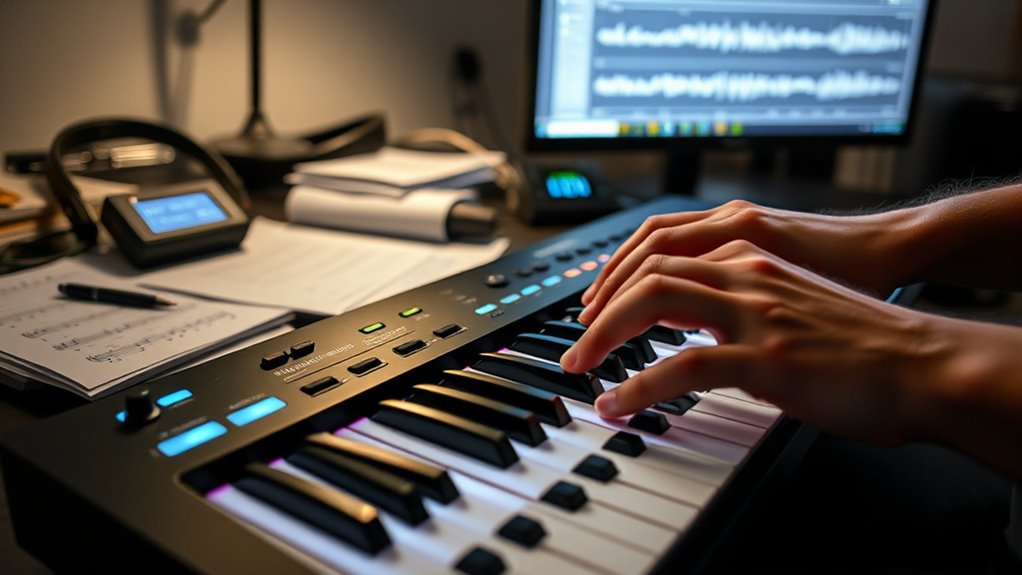
When aiming for precise MIDI input, slowing down your playing can considerably improve accuracy. It allows you to focus on timing consistency and note articulation, ensuring each note is intentional. To practice deliberately, set your MIDI controller to a slower tempo and play each note with care. Visualize your fingers gently pressing keys, emphasizing control over speed. Imagine:
- Carefully lining up each note with the beat
- Maintaining even spacing between notes
- Clearly articulating each note’s attack and decay
- Avoiding rushing through passages
This approach helps you develop a steady sense of timing and ensures your MIDI data accurately reflects your musical intention. Additionally, understanding risk assessment for merchant services can help you identify and mitigate potential issues in your workflow. By practicing slowly, you gain better control over note articulation and build a solid foundation for faster, more confident playing later.
Using Quantization and Humanization Effectively
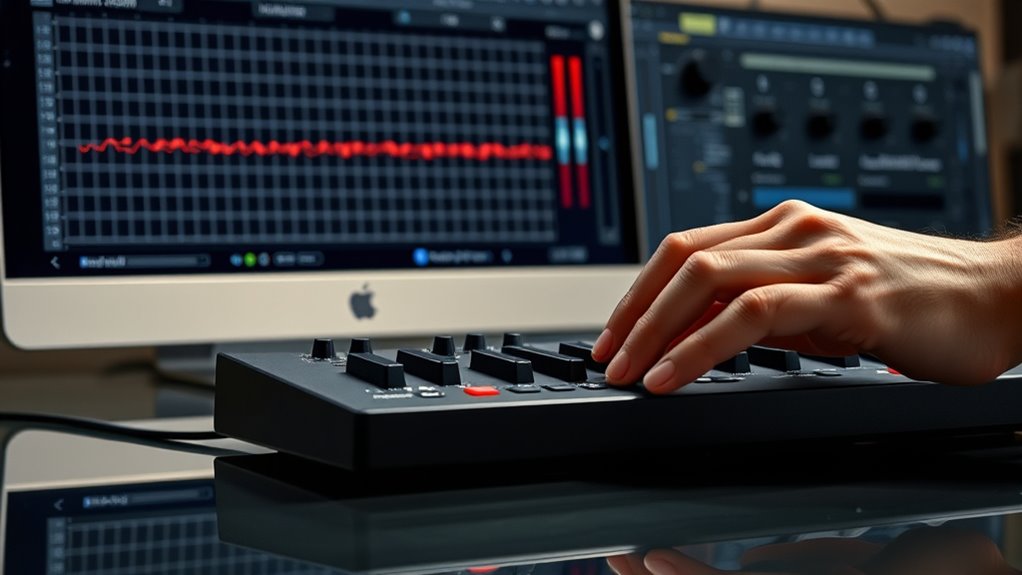
Quantization and humanization are powerful tools for refining your MIDI performances, helping you achieve a balance between precision and natural feel. Humanization techniques add subtle timing and velocity variations, making your MIDI sound more realistic. Use quantization settings carefully; tight settings lock notes precisely, ideal for rigid parts, while looser settings preserve groove. Experiment with different degrees of quantization to find what sounds natural for each passage. Applying humanization thoughtfully can prevent your performance from feeling robotic, especially when combined with gentler quantization. Remember, the goal isn’t perfect timing but a natural, expressive feel. Adjust these tools based on your musical style, and always listen critically—fine-tuning these settings ensures your MIDI performance maintains both accuracy and musicality. Incorporating sound design principles can also help shape the sonic character of your MIDI, adding texture and depth.
Analyzing and Refining Your MIDI Creations
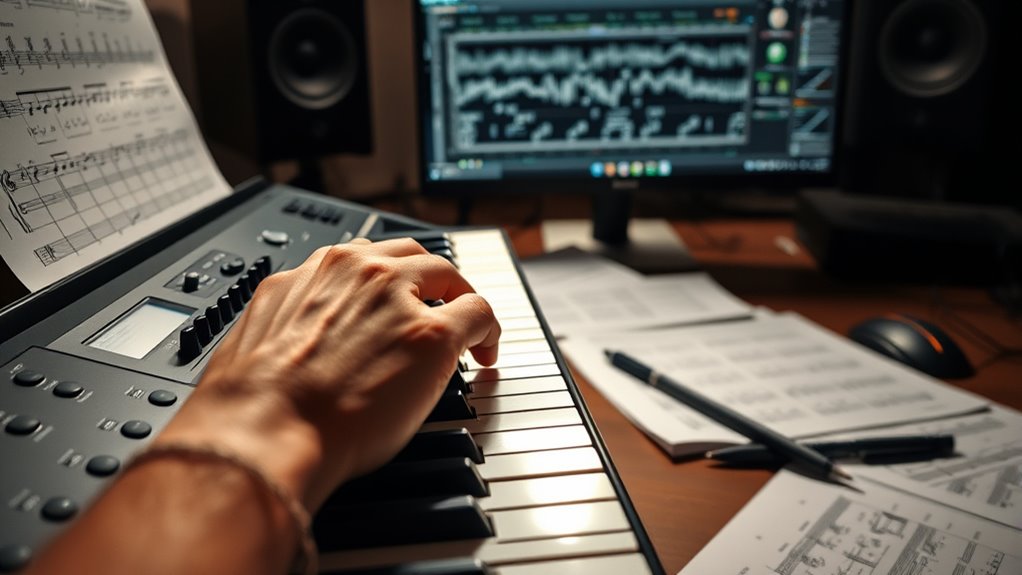
Analyzing and refining your MIDI creations is a crucial step to guarantee your performance sounds polished and expressive. You’ll want to listen carefully, focusing on musical phrasing and timing consistency. As you review, imagine:
Refine your MIDI performances by focusing on phrasing, timing, and dynamics for a polished, expressive sound.
- Fine-tuning the natural flow of melodic lines to enhance musical phrasing
- Correcting subtle timing issues that disrupt groove or feel
- Adjusting velocities to add dynamics and emotion
- Removing accidental clicks or unwanted noise for clarity
- Consulting retail hours to plan your editing sessions during optimal store hours for access to music supplies and tools
Transitioning From Accuracy to Efficiency in Your Workflow
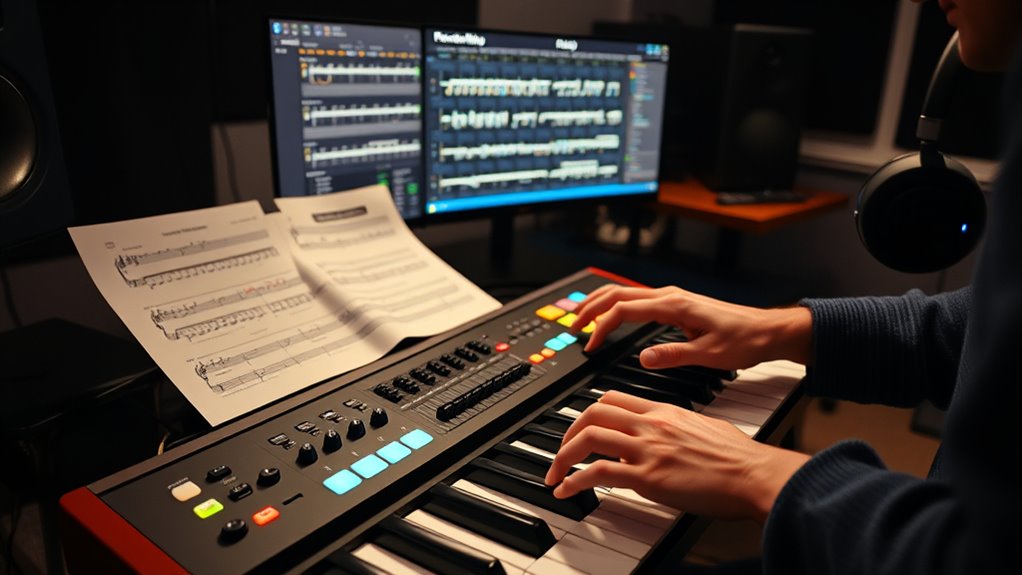
After refining your MIDI recordings for clarity and expression, shifting focus toward efficiency can considerably speed up your workflow. To do this, prioritize mastering studio ergonomics—organize your workspace for easy access to tools and comfortable movement. This reduces wasted time and physical strain, allowing you to focus on musical phrasing and creative decisions. Practice repetitive tasks to develop muscle memory, enabling quicker adjustments without sacrificing accuracy. Use shortcuts and templates to streamline common processes, freeing you to concentrate on the musicality of your MIDI programming. As you become more efficient, you’ll find that your workflow becomes smoother, giving you more time to experiment and refine your musical ideas without losing precision. Incorporating industry trends into your process can also help you stay current and adaptable as technology evolves.
Frequently Asked Questions
How Long Should I Practice to See Improvement in MIDI Accuracy?
You might wonder how long to practice to see improvement in MIDI accuracy. Consistent practice is key—spend at least 15-30 minutes daily focusing on precision. Over time, this regular effort boosts your skill progression. Remember, quality matters more than quantity. As you practice consistently, you’ll notice steady improvements, and your MIDI programming accuracy will become more natural and precise. Keep at it, and progress will follow.
What Are Common Mistakes That Hinder MIDI Precision?
Your MIDI precision can be ruined faster than a snowball in hell if you ignore common mistakes. Beware of quantization errors that make notes jittery and timing inconsistencies that throw off the groove. Many programmers rush, neglecting proper rhythm checks, leading to sloppy timing. Focus on steady practice, double-check your quantization settings, and listen carefully to catch these errors. This will help you improve accuracy and develop a tight, professional sound.
How Can I Stay Motivated During Slow, Deliberate Practice Sessions?
To stay motivated during slow, deliberate practice sessions, adopt mindset strategies that focus on growth and progress. Remind yourself that mastery takes time, and each small improvement counts. Incorporate reward systems by setting achievable goals and celebrating milestones. This keeps your motivation high, helps you stay committed, and makes practice more enjoyable. Remember, consistency and patience are key to becoming a pro at MIDI programming.
Should I Focus on Speed or Accuracy First in MIDI Programming?
You might think speed is king, but in MIDI programming, accuracy actually unlocks true musical expression. Focusing on technical precision first helps you build a solid foundation, making faster, more complex sequences smoother later. Ironically, rushing for speed can hinder your progress and diminish musical nuance. Prioritize accuracy, master the details, and speed will naturally follow—allowing your MIDI programming to sound polished and expressive.
What Tools or Plugins Can Help Improve MIDI Timing and Accuracy?
To improve your MIDI timing and accuracy, you should explore quantization plugins and timing correction tools. Quantization plugins help align your notes precisely to the grid, making your performance tighter. Timing correction features automatically fix slight timing errors, ensuring your MIDI data stays consistent. Using these tools regularly will sharpen your skills, making your MIDI programming sound more professional and polished without sacrificing musical feel.
Conclusion
Remember, mastering MIDI programming isn’t just about speed—it’s about precision and artistry. By focusing on accuracy first, you’ll build a strong foundation that naturally leads to faster, more confident work. Are you willing to prioritize quality over haste today? Embrace deliberate practice, refine your skills, and watch your creativity flourish as you strike the perfect balance between accuracy and efficiency. Ultimately, it’s your dedication that transforms good into great.

